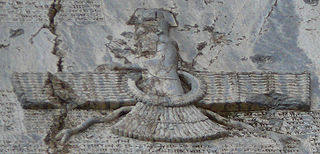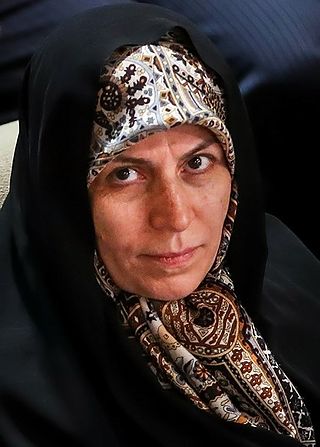The Persians are an Iranian ethnic group who comprise over half of the population of Iran. They share a common cultural system and are native speakers of the Persian language as well as of the languages that are closely related to Persian.

Bushehr Province is one of the 31 provinces of Iran. It is in the south of the country, with a long coastline on the Persian Gulf. The city of Bushehr is the provincial capital. At the 2006 census, the province's population was 886,490 in 188,762 households. The following census in 2011 counted 1,032,949 people in 246,742 households. At the 2016 census, the province's population was 1,163,400 in 321,826 households.

Hormozgan Province is one of the 31 provinces of Iran. It is in the south of the country, in Iran's Region 2, facing Oman, UAE and the Hormuz Straits. Its area is 70,697 km2 (27,296 sq mi), and its provincial capital is Bandar Abbas. The province has fourteen islands in the Persian Gulf and 1,000 km (620 mi) of coastline.

Kermanshah Province is one of the 31 provinces of Iran and one of the provinces which border Iraq. The province was known from 1969 to 1986 as Kermanshahan, and from 1986 to 1995 as Bakhtaran. The capital of the province is the city of Kermanshah. According to a 2014 segmentation by the Ministry of Interior, it is the center of Region 4, with the region's central secretariat located in Kermanshah. A majority of people in Kermanshah Province are Shia, and there are Sunni and Yarsani minority groups.

Semnan Province is one of the 31 provinces of Iran. It is in the north of the country, with its center and capital in the city of Semnan. The province of Semnan covers an area of 96,816 square kilometers and stretches along the Alborz mountain range, bordering on Dasht-e Kavir desert in its southern parts.

Pasargadae /pə'sɑrgədi/ was the capital of the Achaemenid Empire under Cyrus the Great. Today it is an archaeological site located just north of the town of Madar-e-Soleyman and about 90 kilometres (56 mi) to the northeast of the modern city of Shiraz. It is one of Iran's UNESCO World Heritage Sites. It is considered to be the location of the Tomb of Cyrus, a tomb previously attributed to Madar-e-Soleyman, the "Mother of Solomon".

Naqsh-e Rostam is an ancient archeological site and necropolis located about 12 km northwest of Persepolis, in Fars Province, Iran. A collection of ancient Iranian rock reliefs are cut into the face of the mountain and the mountain contains the final resting place of four Achaemenid kings, notably king Darius the Great and his son, Xerxes. This site is of great significance to the history of Iran and to Iranians, as it contains various archeological sites carved into the rock wall through time for more than a millennium from the Elamites and Achaemenids to Sassanians. It lies a few hundred meters from Naqsh-e Rajab, with a further four Sassanid rock reliefs, three celebrating kings and one a high priest.
The Median language was the language of the Medes. It is an Old Iranian language and classified as belonging to the Northwestern Iranian subfamily, which includes many other languages such as Kurdish, Old Azeri, Talysh, Gilaki, Mazandarani, Zaza–Gorani and Baluchi.

Kermanshah, is the capital of Kermanshah Province, located 525 kilometres from Tehran in the western part of Iran. According to the 2016 census, its population is 946,681. A majority of the people of Kermanshah are bilingual in Southern Kurdish and Persian, and the city is the largest Kurdish city in Iran. Kermanshah has a moderate and mountainous climate. Most of the inhabitants of Kermanshah are Shia Muslims, but there are also Sunni Muslims, Christians, and followers of Yarsanism.

Kharg or Khark Island is a continental island in the Persian Gulf belonging to Iran. The island is located 25 km (16 mi) off the coast of Iran and 483 km (300 mi) northwest of the Strait of Hormuz. Its total area is 20 km2 (7.7 sq mi). Administered by the adjacent coastal Bushehr Province, Khark Island provides a sea port for the export of oil and extends Iranian territorial sea claims into the Persian Gulf oil fields. Located on Khark Island is Khark, the only city in the Khark District.

Failaka Island is a Kuwaiti Island in the Persian Gulf. The island is 20 km off the coast of Kuwait City in the Persian Gulf. The name "Failaka" is thought to be derived from the ancient Greek φυλάκιο(ν) – fylakio(n) "outpost".

Greater Iran also known as Persosphere refers to a sociocultural region in which Iranian traditions and Iranian languages have had a significant impact. It spans parts of Western Asia, the Caucasus, Central Asia, South Asia, and Xinjiang. The region is defined by having been long-ruled by the dynasties of various Iranian empires, under whom the local populaces gradually incorporated some degree of Iranian influence into their cultural and/or linguistic traditions; or alternatively as where a considerable number of Iranian peoples settled to still maintain communities who patronize their respective cultures, geographically corresponding to the areas surrounding the Iranian plateau. It is referred to as the "Iranian Cultural Continent" by Encyclopædia Iranica.

Darreh Shahr County is in Ilam province, Iran. The capital of the county is the city of Darreh Shahr. At the 2006 census, the county's population was 56,346 in 11,487 households. The following census in 2011 counted 59,551 people in 14,867 households. At the 2016 census, the county's population was 43,708 in 12,012 households, by which time Badreh District had been separated from the county to form Badreh County.

Nasser Pourpirar was a famous Iranian writer and historical revisionist. He was known for his controversial theories questioning the academically recognized historiography of Iran from Achaemenids to the beginning of the Safavid period.
Dashtak is a village in the Dorudzan District, Marvdasht County, Fars Province, Iran. At the 2006 census, its population was 2,109, in 542 families.

Zahra Ahmadipour is an Iranian politician and university professor who was the head of Cultural Heritage, Handcrafts and Tourism Organization from 2016 until 2017. She was formerly Director of administrative divisions of the Ministry of Interior for two times, first from 1997 until 2003 and the second time in 2016. She was also Vice President of the Physical Education Organization from 2003 until 2005.
Kuwaiti Persian, known in Kuwait as ʿīmi is a combination of different varieties of the Persian language and Achomi language that has been spoken in Kuwait for more than 300 years. Persian was spoken since the foundation of Kuwait, especially in the Sharq district of the historical Kuwait City, where families that emigrated from Persia had settled.

The Imam Hasan al-Askari Mosque dates from the Abbasid Caliphate and is located in Qom.
The Comprehensive History of Iran is a twenty-volume book series about various aspects of Iran's political, social and cultural history from pre-Islamic times to the extinction of the Qajar dynasty. The research, compilation and writing of this multi-volume book has lasted for 14 years. The first five volumes of this series narrate the period of ancient Iran and the other 15 volumes narrate the history of Iran in the Islamic period, political, social, cultural, scientific, literary and artistic history. One hundred and seventy foreign and domestic authors have been used to write this multi-volume book.
Khargi is a Southwestern Iranian language spoken on the Iranian island of Kharg in the Persian Gulf.














